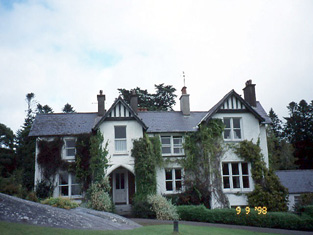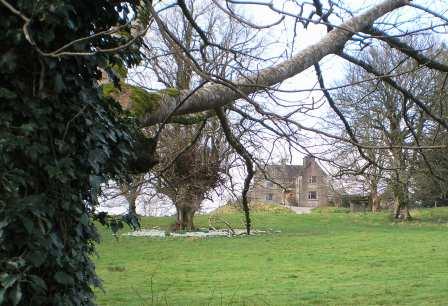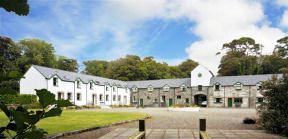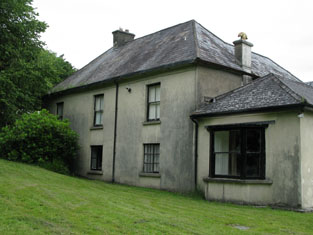Glengarriff Lodge
Houses within 15km of this house
Displaying 42 houses.
Houses within 15km of Glengarriff Lodge
Displaying 42 houses.
| House name | Description | |
|---|---|---|
| Parkgariffe | The representatives of Reverend D. Mahony were leasing a house valued at £9 to Barbara Strange at the time of Griffith’s Valuation. This property was included in the sale of the Freeman estate in 1850, when it was occupied by Mrs. Elizabeth Strange, under a lease dating from 1828. Bary states that it was later lived in by the Spottiswood Green family. There is still an occupied house at the site but it may have been altered. | |
| Dromore Castle | The reps of Rev. D. Mahony were occupying a property valued at £66, at the time of Griffith’s Valuation. Lewis mentions " a noble edifice in the Gothic castellated style" as the seat of Rev. Denis Mahony in 1837. In 1814, Leet noted Dromore as the seat of John Mahony. In 1906 it was owned by H.S. Mahony and valued at £66 15s. Bary states that it was built by Sir Thomas Deane for Rev. Denis Mahony in the 1830s. It remained in the Mahony family until the early years of the twentieth century. It then passed by marriage to the Hood family. The Irish Tourist Association survey in 1943 indicates it was the property of Colonel E. Hood whose wife was "the last of the O'Mahonys, a family associated with the area for over 300 years". It later pass from them to the Wallers, cousins of the Hoods. Dromore Castle is still extant and the National Inventory of Architectural Heritage states that it was renovated in 1998. |

|
| Dunkerron House | Lewis records that Dr. Taylor was occupying a property adjacent to the ruined castle at Dunkerron in 1837. In 1814, Leet refers to Dunkerrin Castle as the seat of George Cashell. At the time of Griffith’s Valuation, Joseph Taylor was leasing a property there valued at £16 15s from Deane Freeman. Bary states that Joseph Taylor was an agent for the Landsdowne estate. The Taylor property then passed to Dr. Thomas Taylor who built Dunkerron House. In 1906 this was the property of Sir John C. Columb and valued at £22. The property is still extant but extensive housing development has taken place in the demesne. | |
| Tubbrid House | At the time of Griffith's Valuation, John M. Hickson was occupying Tubbrid House, parish of Templenoe, valued at £9. Bary states that the house was built by the [O]'Mahony-Hickson family. There is still an occupied house at the site though it may have been altered. . | |
| Derreen | Peter McSweeney was leasing the property at Derreen from the Lansdowne estate at the time of Griffith's Valuation, when it was valued at £6 10s. Lewis also notes it as his residence in 1837. Bary states that Derreen was originally built by a branch of the O'Sullivans from whom it passed to Peter McSweeney who was married to a member of that family. It formed part of the Lansdowne estate and later came into the possession of the Petty-Fitzmaurices. In 1906 it was owned by that estate and was valued at £53 15. It was burnt in the early 1920s but rebuilt in the same style and is still extant and occupied. It is famous for its beautiful gardens. |

|
| Dromneavane | Rev. John O'Sullivan was leasing a property valued at £8 5s from the Lansdowne estate at the time of Griffith's Valuation. Labelled Dromneavane on both the 1st-edition and 25-inch Ordnance Survey Maps. A house still exists at the site. | |
| Lansdowne Lodge | William S. Trench, Lord Lansdowne's agent, was occupying this property at the time of Griffith's Valuation, when it was valued at £27. In 1837 Lewis refers to it as the residence of the then agent, J. Hickson. Bary states that it was the home of the various agents of the Lansdowne estate throughout the nineteenth and early twentieth centuries. It was demolished in the latter decades of the twentieth century and a housing estate built on the grounds. | |
| Reenmore House | Rev. John Day was leasing a property valued at £12 15s from the Lansdowne estate at the time of Griffith's Valuation. This may have been the conjoined property labelled Sound House and Fir View on the 1st edition Ordnance Survey Map. On the 25-inch map of the 1890s, Sound House has become known as Reenmore House. The are still extant buildings at the site. | |
| Sheen Cottage/The Falls | George Woodhouse was leasing a property valued at £6 from the Lansdowne estate at the time of Griffith's Valuation. On the 1st edition OS map the house in this townland is named Sheen Cottage. On the 25-inch map of the 1890s it is labelled The Falls. It is now the Sheen Falls Lodge hotel. See www.sheenfallslodge.ie. |

|
| Riversdale (Kenmare) | George Mayberry, MD, was leasing Riversdale from the Lansdowne estate at the time of Griffith's Valuation, when it was valued at £12 5s. Bary states that the house was in the Mayberry family until the early twentieth century when it was pruchased by the Representative Church Body who owned it until the 1960s. It is now an hotel. |

|
| The Cottage (Kenmare) | At the time of Griffith's Valuation, Francis Downing was a leasing a property at Mucksna, Kenmare, to Agnes Godfrey, when it was valued at £9. This may be the property which Bary refers to as Tom Moore's cottage, still extant and occupied. | |
| Roughty Lodge | According to Bary, Roughty Lodge was owned by Capt. Massey Herbert in the 1820s. At the time of Griffith's Valuation, it was being leased by Mrs. Elizabeth Herbert, nee Orpen from John Dunscum and was valued at £9. It is still extant and in 2009 was offered for sale. |

|
| Shelburne Lodge | In 1786 Wilson refers to "the Earl of Shelburne's lodge at Kenmare". William Lawrenson was leasing Shelbourne Lodge at the time of Griffith's Valuation when it was valued at £10. The lessor is named as Garrett Riordan though Bary states that the house was part of the Lansdowne estate and may, in the eighteenth century, have been used by the estate agent. It has had several owners since its sale in the early twentieth century but is still extant and now run as a guesthouse. See www.shelburnelodge.com |

|
| Greenlane | At the time of Griffith's Valuation, George Mayberry owned this property, valued at £9. Lewis refers to is as the seat of Mrs.Mayberry in 1837 and Leet as the residence of John Maybury in 1814. In 1906 it was owned by Francis Mayberry and valued at £5. Bary states that it was in the possession of the Maybury family from the eighteenth century until the 1940s. Prior to that it was associated with the Duckett family. It was demolished in the later twentieth century. | |
| Killowen House | At the time of Griffith's Valuation, Edward Orpen was leasing this property from the Landsdowne estate when it was valued at £3. Lewis mentions it as the occasional residence of H. Orpen in 1837. In the 1770s it was noted by Taylor and Skinner but no proprietor is given. Bary notes that this property was originally in the possession of the Taylor estate but was was taken over by the Orpens in the early eighteenth century. It passed through marriage to the Palmer family. It was demolished in the twentieth century | |
| Marino Lodge | In 1906 John Columb owned this property, then valued at £6 10s. There are two bathing lodges in this area at the time of Griffith's Valuation, Marino Lodge and Clashganniv. These properties seem to have been part of the Langford estate. | |
| Reenmeen Cottage | Leased by Robert White from the Bantry estate in 1852 when it was valued at £11+. Named as Reenmeen Cottage by Lewis who notes it as the seat of R. White in 1837. Buildings still exist at the site. A house named Glengarriff Cottage (V939564) appears on the 1st edition Ordnance Map in this townland but is not visible on the later 25-inch map. | |
| Glengarriff or Eccles Hotel | Thomas Eccles was leasing this property from the Earl of Bantry's estate in 1852 when it was valued at £21+. It is labelled on the 1st Edition Ordnance Survey Map as Glengarriff Hotel but is better known now as the Eccles Hotel, one of Ireland's oldest hotels. In April 1875, following the death of Thomas Eccles, the hotel was offered for sale in the Landed Estates Court. A detailed history is available at www.eccleshotel.com. |

|
| Adrigole House | Rev. Richard Wright was leasing this property from the Bantry estate in 1852 when it was valued at £9. It is labelled Ardrigole Parsonage on the 1st edition Ordnance Survey map but appears as Adrigole House on the 25-inch edition of the 1890s. IN the early 1940s the Irish Tourist Association survey described it as "an old square building completely covered in ivy" and the property of a Mr. Crowley. It is still extant and has been offered for sale in recent years. | |
| Reen Lodge | Leased by Robert White from the Bantry estate in 1852 when the house was valued at £10+. Noted by Leet as the residence of Rev. William Hodnett in 1814. In the later half of the nineteenth century it seems to have been occupied by the Leonard family. Documents in relation to it exist in the Bantry Estate papers. The Irish Tourist Association survey in the 1940s refer to it as owned by Mr. Regan. It is still extant and occupied. | |
| Ardnagashel House | Samuel Hutchins held this property in fee in 1852 when it was valued at almost £23. Lewis noted it as the seat of A. Hutchins in 1837. In 1906 it was owned by Samuel N. Hutchins and valued at £30. The original house has been demolished and the stableyard converted to self-catering accommodation. The Irish Tourist Association survey of the 1940s mentions that the grounds contained some fine trees including a cork tree which came originally from Kew Gardens. |

|
| Ballylicky House | Arthur Hutchins was leasing this house from the Earl of Kenmare's estate in 1852 when it was valued at almost £14. In 1837 Lewis refers to it as the seat of S. Hutchins. Later associated with the Graves family. The Irish Tourist Association survey of the 1940s noted that it was already being run as a guesthouse at that time and it is now a luxury hotel. |

|
| Dunnamark House | Leased by Alicia Tisdall from Samuel Hutchins at the time of Griffith's Valuation, when it was valued at £8 5s. In the 1940s the Irish Tourist Association survey noted that it was the residence of Dr. Nunan. There is still an extant house at the site. | |
| Dunnamark Mill | Michael Murphy was leasing this property, including a mill, from the Kenmare estate in 1852, when it was valued at £35. The building is labelled Barytes Mill on the 25-inch Ordnance Survey map of the 1890s. It is now a ruin. | |
| Gurteenroe House | John Shea Lalor was leasing Gurteenroe from the Kenmare estate in 1852 when it was valued at £10 10s. Lewis noted it as his residence in 1837. It appears to have been occupied by a Gallway family in the 1780s as both Taylor and Skinner and Wilson mention a residence of that family in this area. It is now a ruin. | |
| Newtown (Bantry) | Held in fee by the Earl of Kenmare's estate in 1852 when it was valued at £8 5s. Lewis refers to it as the seat of M. Murphy in 1837. There is still an extant house at the site. | |
| Reenydonagan House | Leased by Roger O'Sullivan from the Kenmare estate in 1852 when it was valued at £12. Lewis notes it as the seat of D. O'Sullivan in 1837. The house is still extant and operates as a guesthouse. |

|
| Ivy Cottage (Bantry) | Jeremiah O'Connell was leasing this property from Robert E. White at the time of Griffith's Valuation, when it was valued at £24. A substantial farmyard was located nearby. By the later nineteenth century the house appears to have been known as Beach Cottage. A slightly later building, known as Ardeevin House, exists at this site now. |

|
| Caherdaniel House (Bantry) | Leased from the Bantry estate by John Cotter at the time of Griffith's Valuation, when it was valued at almost £9. Occupied buildings still survive at the site. | |
| The Vicarage (Bantry) | Rev. John Murphy was leasing the Vicarage from the Bantry estate at the time of Griffith's Valuation, when it was valued at almost £21. The house is still extant and occupied. |

|
| Carriganass Castle | Held by William O'Sullivan from the Bantry estate in 1852 when it was valued at £15 10s. Lewis refers to it as the seat of W. O'Sullivan in 1837. Slater refers to it as the seat of J.E. Barrett in 1894. The house takes its name from the original O'Sullivan castle located a short distance away. | |
| Drombrow House | Occupied by Hamilton White, leasing from the Bantry estate, in 1852, when it was valued at almost £16. Lewis records "Drumbree Cottage" as the seat of J. White in 1837. Drombrow was the property of Arthur B. Wilkinson in 1906 and valued at almost £15. |

|
| Glengarriff Castle | Sarah White was leasing this property from the Bantry estate at the time of Griffith's Valuation, when it was valued at almost £36. In 1837, Lewis described it as "Glengarriff Castle, the seat of Captain White, is a spacious elegant mansion". Local sources suggest the Castle was built in the 1790s by Simon White, a brother of the 1st Earl of Bantry. Noted by Leet as the seat of Simon White in 1814. In 1894 Slater refers to it as the seat of R.H.E. White. It functioned as a resort until the 1970s. Plans are currently in progress to restore the building. |

|
| Bay View (Bantry) | Samuel Daly was leasing this property from the Earl of Bantry's estate in 1852 when it was valued at over £32. It is not named on the 1st edition Ordnance Survey Map but appears as Bay View on the 25-inch map of the 1890s. There is still an extant house at the site. | |
| Inchiclogh House | Hamilton White held this property in fee in 1852 when it was valued at almost £34. Lewis refers to it as the seat of R. White in 1837. It is included in the Encumbered Estates Sale Notice of December 1852, which indicates that it was held by Elizabeth White, a widow, by lease from the Court of Chancery. The property does not appear on the 25-inch Ordnance Survey map of the 1890s. | |
| Lisheen House (Bantry) | Rev. John Orpen was leasing this property from John Herbert Orpen in 1852 when it was valued at £14. In 1837 Lewis described it as " a handsome residence for which the late Board of First Fruits granted a loan of £1500". It is named as Lisheen House on the 25-inch Ordnance Survey map of the 1890s. It is no longer extant. | |
| Coomhola Lodge (Sans Souci) (Bantry) | Occupied by Richard E. White at the time of Griffith's Valuation, when it was valued at £8. It is labelled as Sans Souci on the 1st edition Ordnance Map but as Coomhola Lodge on the 25-inch edition of the 1890s. Local sources indicate it was formerly a hunting lodge for the Bantry Estate. It is still extant. | |
| Reenadisert Court | Leased by Robert Warren from the Bantry estate at the time of Griffith's Valuation when it was valued at almost £6. It was originally a seventeenth century fortified house built by the O'Sullivans and is now in ruins. A second property, Reenadisert Cottage (W000531), appears on the 25-inch Ordnance Survey map of the 1890s but this has now disappeared. |

|
| Bantry House | Bantry House was held in fee by the Earl of Bantry at the time of Griffith's Valuation, when it was valued at £125. The house history indicates it has been the home of the White family since about 1765 when Richard White purchased what was then Blackrock House. Wilson still refers to it by the latter name in 1786 but it is named Bantry House on the 1st edition Ordnance Survey map of the 1830s. The Irish Tourist Association survey of the 1940s contains a detailed description of the house's interior at that time. Bantry House has been open to the public since 1946 and a prestigous music festival is held there each summer. For more information see www.bantryhouse.com. |

|
| Trawnahaha | Elizabeth Vickery was leasing this property on Whiddy Island from the Earl of Bantry's estate in 1852 when it was valued at £14. It is not named on the 1st edition OS map and the grid reference is approximate. | |
| Trawnamaddree | Cornelius Rohane was leasing this property from the Bantry estate in 1852 when it was valued at £10. It is not labelled on the 1st edition Ordnance Survey map and the grid reference is approximate. | |
| The Shrubberies (Kenmare) | At the time of Griffith's Valuation, Kenmare Board of Poor Law Guardians were leasing this property from Nathaniel Irvine as an Auxiliary workhouse, when it was valued at £37. On the 1st edition Ordnance Survey map it is labelled Monastery but on the later 25-inch Map of the 1890s it appears as The Shrubberies. It is still extant. |

